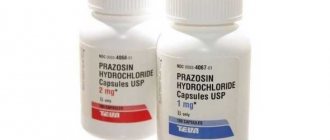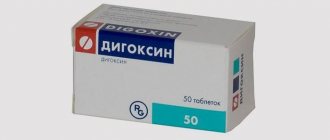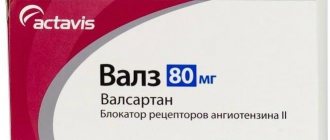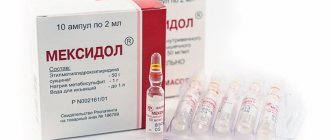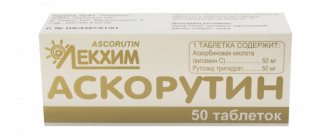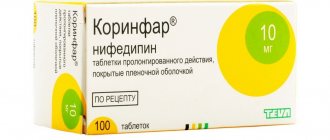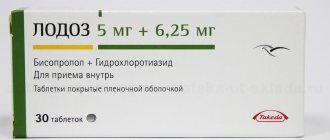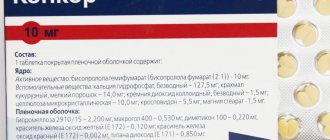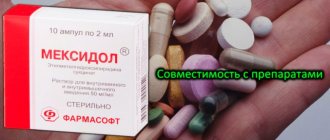Brief information about the drug
Co-Dalneva's blood pressure medicine belongs to the pharmacological group of antihypertensive drugs, angiotensin-converting enzyme inhibitors. Produced in Slovenia.
Release form
The blood pressure medicine Ko-Dalneva is presented on the modern pharmaceutical market in the most convenient tablet form for dosing and use at home. Sold in blisters (10 or 14 tablets). The medicine can also be purchased in cardboard packages containing 10 blisters from 2 dollars.
Compound
The drug contains 3 main active components:
- indapamide - 0.625, 1.25 or 2.5 mg;
- perindopril - at a dose of 10.206, 20.412 or 40.824 mg;
- amlodipine - in the amount of 6.935 or 13.87 mg.
The tablets also contain auxiliary ingredients: magnesium stearate, starch, colloidal silicon dioxide, sodium bicarbonate.
pharmachologic effect
Co-Dalneva for high blood pressure is a drug with a pronounced antianginal and hypotensive effect.
Packaging of Ko-Dalneva tablets
Terms and storage mode
It is recommended to store the medication in its packaging at a temperature not exceeding +25°C. It is important to ensure that children and pets do not have access to the medicine. The maximum permissible shelf life of the drug is 2 years.
Terms of sale
You can purchase a medicine in pharmacy chains only after presenting an appropriate doctor's prescription.
Cost of tablets
The exact cost of the drug is influenced by factors such as the dosage of the main active ingredients, the number of blisters in the pack and tablets in the package. The approximate price of Ko-Dalnev tablets varies from 250 rubles to 1000 rubles.
Composition of the drug Dalneva
This drug contains two active ingredients: amlodipine and perindopril. It is the combination of these substances that allows you to achieve the desired result, that is, lowering blood pressure.
The drug Dalneva 5 is in greatest demand. 5 mg is the amount of amlodipine in this drug.
Based on the instructions for use of Dalnev, we will indicate the amount of active substances in various forms of the drug:
- Dalneva 5 + 4 mg or 10 + 4 mg (Amlodipine 5 or 10 mg in combination with perindopril in an amount of 4 mg).
- Dalneva tablets 5 + 8 mg (Amlodipine 5 milligrams in combination with perindopril 8 milligrams) or 10 + 8 mg implies 10 mg of the first active substance.
Additional substances are:
- cellulose in the form of small crystals, used as a thickener;
- pregelatinized starch used as a filler;
- thickener sodium carboxymethyl starch, which simultaneously improves taste;
- sodium bicarbonate neutralizer;
- colloidal silicon dioxide, used as an enterosorbent;
- stabilizer magnesium stearate.
Amlodipine
Amlodipine is presented as amlodipine besylate. Its quantity depends on the chosen dosage. For tablets 5 + 4 mg and 10 + 4 mg, the amount of amlodipine is respectively 6.935 mg (Dalneva 5 + 4 and Dalneva 5 + and 13.87 mg (Dalneva 10 + 4 and Dalneva 10 + 8).
Its quantity depends on the chosen dosage. For tablets 5 + 4 mg and 10 + 4 mg, the amount of amlodipine is respectively 6.935 mg (Dalneva 5 + 4 and Dalneva 5 + and 13.87 mg (Dalneva 10 + 4 and Dalneva 10 + 8).
Amlodipine belongs to a class of drugs that block calcium channels. Thus, the process of vasoconstriction, provoked by an excess of calcium ions entering the cells of the arterial walls and cardiomyocytes, is inhibited. Examples of diseases associated with spasm of blood vessels are angina pectoris and hypertension. To treat these diseases, patients are prescribed an initial dose of the drug Dalneva 5 + 4.
Instructions for use describe that amlodipine expands the arteries that supply the heart with oxygen in areas prone to ischemia, the oxygen flow into the myocardium increases, and the number of arterial spasms decreases.
Perindopril
Perindopril is the second active ingredient included in Dalneva. The instructions state that perindopril is presented in granules of perindopril erbumine A. Its content in the medicine is 4 milligrams for the dosage of Dalneva 5 + 4 or Dalneva 10 + 4 milligrams and 8 milligrams for the dosages of Dalneva 5 + 8 or 10 + 8 milligrams.
Perindopril belongs to the group of inhibitors of the enzyme responsible for increasing blood pressure - vasoconstriction.
Perindopril has a dilating effect on blood vessels, improves the flexibility of the walls of large arteries and the structure of the membranes of small vessels. During long-term use, the total vascular resistance decreases, which relieves afterload on the heart muscle.
Effect on blood pressure
The blood pressure drug Ko-Dalneva has a complex, combined effect. Amlodipine is characterized by the presence of pronounced antihypertensive properties due to its ability to relax the smooth muscle cellular structures of the vascular walls. It has an antianginal effect, dilating peripheral and coronary arteries. reducing the load on the heart and the quantitative need of the myocardium for oxygen.
Perindopril acts as an ACE inhibitor, suppressing the production of angiotensin, which increases blood pressure. Has vasodilating properties. Promotes accelerated destruction of bradycardin. Has a beneficial effect on the condition and functioning of the heart and blood vessels, with prolonged regular use.
Indapamide is a thiazide diuretic. Activates urination processes, effectively fights swelling and congestion.
Co-Dalneva lowers blood pressure, and the hypotensive effect of the tablets lasts throughout the day, which makes it possible to avoid frequent use of the drug.
It has a good effect on the condition of patients suffering from heart failure due to its ability to increase cardiac output, improve the processes of peripheral blood flow, blood circulation and microcirculation, and reduce the level of pressure in the area of the right and left cardiac ventricles.
Ko-Dalneva is a complex drug for lowering blood pressure
How the drug works
The instructions state that the effect of the drug is caused by the content of two (or three in the case of Ko-Dalnev) active ingredients. We list their actions separately.
Perindopril
This substance belongs to the same group as the well-known enalapril or captopril, that is, angiotensin-converting enzyme inhibitors (ACE inhibitors). The inactive protein angiotensin I constantly circulates in the human blood, which is transformed into angiotensin II by the action of a converting enzyme. The latter is a strong substance that constricts blood vessels. Another property of ACE is the ability to destroy bradykinin, a compound found in the blood that has vasodilatory properties.
Under the influence of perindopril, ACE activity is inhibited. As a result, the degree of transformation of angiotensin I into angiotensin II decreases, renin production increases, aldosterone activity decreases, and the kallikrein-kinin system is activated.
What does this mean in practice? Perindopril has a therapeutic effect for hypertension of any severity. It lowers both “upper” (systolic) and “lower” (diastolic) blood pressure. In this case, the patient’s position (lying or standing) does not affect the effect of the medicine.
By dilating small vessels located in distant tissues, perindopril reduces the resistance of blood vessels in peripheral tissues to blood flow, as a result it flows well into the organs and ensures their supply of oxygen. In particular, blood flow in the kidneys improves. A decrease in resistance also leads to a decrease in pressure in the vascular system.
After a single use of the drug, its maximum level in the blood is recorded after 6 hours and continues throughout the day. The decrease in pressure lasts the same amount of time. If you take perindopril or combinations containing it regularly, the full therapeutic effect will develop within one month. The advantage of the medicine is that the decrease in blood pressure caused by its use is not accompanied by an increase in heart rate.
What is Ko-Dalneva prescribed for?
Therapists and cardiologists strongly recommend that patients drink Co-Dalneva for high blood pressure if they have the following clinical indications for use:
- Arterial hypertension;
- Hypertonic disease;
- Essential hypertension.
- Chronic heart failure.
The tablets are prescribed to people with diagnosed hypertension who require concomitant treatment with perindopril, amlodipine and indapamide. The drug is especially effective in severe forms of arterial hypertension, accompanied by a significant increase in blood pressure, edema, increased heart rate, and heart rhythm disturbances. Helps avoid the development of heart failure or eliminate its symptoms.
Analogs
In cases where the expected effect of the drug is not observed or side effects are present, a replacement for the drug Dalneva is found. Analogues contain the same active ingredients (amlodipine and perindopril), but in different concentrations. There are two such drugs - Parnavel Amlo and Prestance.
The first of them (Parnavel Amlo) is available in four versions. Each of them contains the same amount of active substances as Dalneva.
The instructions for use state that Prestans has the following release forms:
- tablets 5 milligrams of perindlopril + 5 milligrams of amlodipine;
- tablets 10 mg + 10 mg of corresponding active ingredients;
- drug 5 mg + 10 mg;
- Prestans 10 + 5 mg. The first number indicates the amount of perindopril, the second - amlodipine.
Each drug differs in the dose of the active substance, additional components, manufacturer and cost.
What are the contraindications
The drug Ko-Dalneva for hypertension is strictly contraindicated for use by patients in the following clinical cases:
- Hypotonic disease (stably low blood pressure);
- Angioedema hereditary or idiopathic edema;
- Individual intolerance and hypersensitivity to the components contained in the tablets;
- Unstable angina;
- Severe form of liver dysfunction;
- State of shock (including cardiogenic nature);
- Hypokalemia;
- Arterial stenosis in the presence of one kidney
- An unstable form of heart failure that developed after suffering an acute attack of myocardial infarction;
- Renal dysfunction;
- Hepatic encephalopathy;
- Heart failure occurring in the decompensation stage;
- The patient is a minor;
- The period of the hemodialysis procedure;
- The patient has a history of angioedema that occurred during therapy with ACE inhibitors;
- Bilateral renal artery stenosis.
Tablets should not be used to treat patients forced to take lithium drugs, diuretics, potassium-containing drugs, Alixiren.
The medication is prescribed with great caution to persons with diagnosed diabetes mellitus.
For kidney disease, tablets are contraindicated
Undesirable combination with other drugs
The instructions do not recommend using Dalneva and Ko-Dalneva simultaneously with the following medications:
- potassium-sparing diuretics (veroshpiron, spironolactone), potassium preparations (asparkam, panangin), table salt surrogates containing potassium instead of sodium - likely a significant increase in the amount of potassium in the body and disruption of the heart;
- lithium preparations – the development of its toxic effects is possible;
- dantrolene intravenously – possible heart rhythm disturbance;
- estramustine - angioedema is likely.
With extreme caution and regular monitoring of relevant indicators, these medications should be taken with the following drugs:
- non-steroidal anti-inflammatory drugs, including aspirin - may increase blood pressure and worsen kidney function;
- diabetes medications or insulin - likely to lower blood sugar;
- rifampicin, St. John's wort, anticonvulsants - there is a risk of increased blood pressure;
- antifungal agents (itraconazole, ketoconazole), macrolide antibacterial drugs (erythromycin, clarithromycin), verapamil and diltiazem - adverse effects of amlodipine are likely to occur;
- baclofen – a sharp decrease in blood pressure is possible.
Combinations requiring physician attention:
- bisoprolol, metoprolol and carvedilol - possible increased shortness of breath, swelling, decreased blood pressure;
- hypothiazide and furosemide – a strong decrease in blood pressure is possible;
- sympathomimetics, for example, drugs for the treatment of asthma - likely to increase blood pressure;
- gold preparations - there may be a rush of blood to the head, nausea and vomiting, and decreased blood pressure;
- immunosuppressants, glucocorticoids and procainamide - likely to reduce the level of leukocytes in the blood;
- drugs for general anesthesia, tricyclic antidepressants and antipsychotics – a decrease in blood pressure cannot be ruled out;
- nitrates (nitroglycerin and others) – hypotension is possible;
- alpha-blockers (prazosin, doxazosin and others) – increased hypotensive effect.
Complete analogues of the drug Dalneva in terms of the active substance are the Russian drugs “Amlodipine + Perindopril” and “Prestans”, produced by the Servier Laboratory. Prestance has a wide range of dosages, which allows you to select the medicine even more precisely. Other combination drugs containing perindopril do not include amlodipine, which compares favorably with the medications described above.
There are analogues of the drug Dalneva according to the groups of active substance (ACE inhibitors with calcium antagonists:
- enalapril and lercanidipine (Coripren, Enanorm, Enap L Combi);
- lisinopril and amlodipine (Tenliza, Equacard, Equator, Eclamise);
- ramipril and felodipine (Triapine);
- ramipril and amlodipine (Egipres).
They all have some slight differences among themselves, but in general their pharmacological action is the same.
The drug Ko-Dalneva has no analogues.
Use during pregnancy and breastfeeding
Taking Co-Dalneva for high blood pressure is strictly prohibited for women expecting the birth of a baby, since by penetrating the placental barrier, the medication can cause significant harm to the baby’s health and provoke congenital pathologies and developmental defects, such as:
- Kidney failure;
- Hyperkalemia;
- Hypotonic disease;
- Oliguria.
If pregnancy is detected during a therapeutic course, the drug must be immediately discontinued and a comprehensive medical examination must be completed. After birth, the baby must be under strict medical supervision for a certain time.
When planning a pregnancy, you should stop taking the pills several months before the expected conception.
Ko-Dalneva tablets are contraindicated for women during breastfeeding. During lactation, you need to either stop taking the drug or transfer the baby to artificial formula.
Interaction
When taking Dalneva together with Baclofen , there is a risk of increasing the hypotensive effect of the drug. With simultaneous use of the drug with drugs with a hypotensive effect, α-blockers ( Tamsulosin , alfuzosin , Prazosin , Terazosin , Doxazosin ), neuroleptics , general anesthesia, tricyclic antidepressants , an increase in the hypotensive effect and the development of orthostatic hypotension . Corticosteroids and tetracosactide reduce the hypotensive effect of Dalnev.
| Not often: in 0.1-1% | Allergy in the form of urticaria |
| Rarely: in 0.01-0.1% | Increased bilirubin levels in the blood |
| Very rare: in 0.001-0.01% | Anemia, decreased levels of leukocytes and platelets in the blood |
How to take Co-Dalneva for arterial hypertension
Instructions for use of Co-Dalneva recommend taking tablets once a day (preferably in the morning), before meals.
The optimal dosage is selected by the doctor individually, taking into account the amount of all components.
The maximum daily dose should not exceed 8 mg of perindopril, 10 mg of amlodipine and 2.5 mg of indapamide.
For patients suffering from pulmonary and renal pathologies, tablets are prescribed in minimal dosages.
The duration of the therapeutic course depends on the exact diagnosis, the stage of development of the pathological process, the present symptoms, the patient’s body’s response to the proposed treatment and other features of a particular clinical case!
It is recommended to take the drug before meals, in the first half of the day.
Instructions for use
In many cases of hypertension, doctors prescribe Dalnev tablets to patients. The instructions for use of the medicine contain many important points that need to be studied before taking it.
How to use?
When treating with any medications, the time and frequency of administration become fundamental keys to a positive effect. Therefore, it is very important to follow the recommendations of the instructions for use of Dalnev.
Take one tablet per day, orally, preferably in the morning before meals.
Dosages
For each patient, the amount of a single dose of Dalneva is determined individually.
The specific dose used is selected after conducting studies on the patient’s body’s reaction to taking the individual components of the drug - amlodipine and perindopril. Due to the variety of dosages, it is possible to change one dose of the drug to another.
The maximum amount of active ingredients taken per day is 10 milligrams for amlodipine and 8 milligrams for perindopril.
The most commonly used dosage is Dalneva 5 + 8 mg. The instructions for use contain instructions that should not be ignored.
special instructions
The instructions for use indicate that the drug Dalneva is not recommended for use by people under the age of majority due to the lack of information about the results of the effect on the body of patients at this age.
The advantage of the medicine is that in old age there is no need to change the dosage.
Patients with pathologies of the kidneys and liver should take the medication with caution.
If the amount of blood cleared by the kidneys in one minute is less than 60 milliliters, then the medicine is contraindicated. For these patients, doses of active substances are selected individually.
People suffering from improper liver function need to monitor their body parameters, since there is no information about the required amount of substances taken. It is necessary to keep the activity of liver enzymes under control. But if jaundice appears, stop taking the medication.
In rare cases of taking Dalneva tablets, swelling of the face, lips, tongue and larynx may occur. In situations of swelling of the tongue and larynx, the drug is discontinued due to difficulty breathing and the likelihood of death due to suffocation. According to the instructions for using Dalnev, it is necessary to inject adrenaline under the skin and provide medical supervision until the edematous manifestations completely disappear.
Instructions for use of Dalneva indicate that treatment with perindopril is not recommended for people with a history of angioedema caused by other causes.
One day before the start of operations and general anesthesia, you should not take Dalneva.
A side effect for patients taking ACE blockers, in one case out of ten thousand, may be intestinal edema. Symptoms of this phenomenon include abdominal pain, accompanied by nausea and vomiting. Therefore, when these symptoms appear, appropriate diagnosis should be carried out.
Patients with diabetes need enhanced monitoring of blood glucose levels while taking Dalneva.
Manifestations of adverse reactions
Treatment of hypertension with Co-Dalneva may cause the following adverse reactions:
- Muscle spasms;
- Sharp and too strong decrease in blood pressure (hypotonic crisis);
- Fainting;
- Vertigo;
- Painful sensations localized in the back of the head and temples;
- Bronchial spasms;
- Decreased visual function;
- Feeling of tinnitus;
- Nausea and vomiting;
- Sleep disorders (insomnia at night and increased sleepiness during the day);
- Skin itching;
- Joint pain;
- Allergic skin rashes;
- Muscle pain;
- Dyspnea;
- Cough syndrome;
- Excessively intense sweating;
- Inflammation of the mucous membranes of the nasal membranes;
- Frequent urge to urinate;
- Lethargy, weakness, asthenia, decreased ability to work;
- Retrosternal pain;
- Increased heart rate (tachycardia);
- Inflammatory processes affecting the pancreas and gastric mucosa;
- A sharp change in weight category (losing weight or, on the contrary, gaining extra pounds);
- Thrombocytopenia (decreased blood clotting rates);
- Painful sensations localized in the abdominal area;
- Dyspeptic disorders;
- Stool disorders (constipation or diarrhea);
- Back pain;
- Peripheral swelling;
- Erectile dysfunction in the stronger sex.
There is a possibility of developing diseases such as myalgia, atralgia, hepatitis, gastritis, pancreatitis, myocardial infarction.
Any deterioration in health that occurs while taking Ko-Dalnev tablets must be reported to your doctor! To eliminate unpleasant symptoms, you may need to replace the drug with one of its analogues or reduce the daily dosage of the medication!
Shortness of breath and difficulty breathing may be side effects
Side effects
A large list of undesirable effects of the drug Co Dalneva is due to its multicomponent nature:
- decrease in the level of leukocytes, platelets, development of anemia;
- allergic manifestations;
- instability of the patient’s body weight (acceptable percentage of weight loss/gain is up to 5%);
- disturbance of sleep and wakefulness, periodic dizziness, headaches, weakness in the body, malaise, sudden changes in mood;
- decreased visual acuity, the appearance of noise sounds, ringing in the ears;
- a sharp decrease in blood pressure, up to collapse, with an incorrectly selected dose of the drug Co. Dalneva, against this background the development of a pre-infarction state, transient ischemic attack;
- cough, sore throat, uncontrollable shortness of breath;
- dyspeptic disorders (pulling pain in the abdomen), nausea, increased gag reflex, bowel dysfunction, exacerbation of chronic pancreatitis, gastritis;
- muscle pain.
To avoid side effects, consultation with a specialist is recommended to select the dose of Co Dalnev and the course of treatment. If adverse reactions occur, a visit to the doctor is required.
Drug overdose
Use of the drug Co-Dalneva in dosages exceeding the maximum permissible may lead to the appearance of the following alarming clinical signs:
- Tachycardia;
- A sharp drop in blood pressure, the development of a hypotensive crisis;
- Nausea and profuse vomiting;
- Convulsive syndrome;
- Peripheral vasodilation;
- Oliguria;
- Severe dizziness;
- Confusion;
- Violation of water and electrolyte balance.
An overdose of Ko-Dalneva can cause the development of a state of shock and the death of the patient! Therefore, if such symptoms occur, it is necessary to call an ambulance, and before the arrival of medical specialists, perform a gastric lavage on the victim, inducing artificial vomiting, allow him to take sorbents, and lie him down with his legs raised above the level of the body.
Further treatment is prescribed by the doctor individually and is symptomatic.
Side effects
Local allergic reactions, nausea, dyspepsia, diarrhea, weight change, tinnitus, agranulocytosis, leukopenia/neutropenia, thrombocytopenia, visual disturbances, headache, drowsiness, sleep disturbance, dizziness, insomnia, tremor, mood lability, fainting, palpitations, cough, shortness of breath, abdominal pain, vomiting, constipation, hepatitis, skin rash and itching, alopecia, increased sweating, myalgia, photosensitivity, muscle spasms, arthralgia, frequent urination, peripheral edema, impotence, increased fatigue, asthenia, malaise.
Drug compatibility
- The combination with non-steroidal anti-inflammatory drugs not only reduces the hypotensive and diuretic effect of Co-Dalneva tablets, but can also provoke dysfunction of the renal apparatus, especially in the elderly.
- Combination with potassium-containing drugs and diuretics is fraught with the development of hyperkalemia.
- Simultaneous use of Co-Dalneva with lithium preparations can cause severe intoxication of the body.
- The administration of injection solutions containing gold during a therapeutic course often causes such undesirable reactions as a strong decrease in blood pressure, nausea and vomiting, and hyperemia of the skin.
- The combination of the drug Co-Dalneva with diuretics threatens the development of arterial hypotension and a hypotensive crisis. In most cases, medical experts recommend stopping taking diuretics several days before the start of the treatment course. To avoid dehydration, it is important to maintain proper drinking regimen (consuming at least 2 liters of liquid throughout the day) and increase the percentage of salt in the daily diet.
- ACE inhibitors reduce the effectiveness and efficiency of Ko-Dalneva tablets.
- Simultaneous use of the drug with cytostatics, Allopurinol, glucocorticosteroids, and immunosuppressive medications significantly increases the risk of developing leukopenia in the patient.
Co-Dalneva is not compatible with all medications
Co-Dalneva tablets 10/2.5/8 mg No. 90
Ko-Dalneva®
Renal dysfunction
Co-Dalneva® is contraindicated in patients with CC less than 60 ml/min. In some patients with hypertension without previous obvious renal impairment, laboratory signs of functional renal failure may appear during therapy. In this case, treatment with the drug should be stopped. In the future, combination therapy can be resumed using low doses of combinations of perindopril and indapamide, or these drugs can be used separately. Such patients require regular monitoring of potassium levels and creatinine concentrations in the blood serum 2 weeks after the start of therapy and every 2 months thereafter.
The development of renal failure more often occurs in patients with severe CHF or initial renal impairment, incl. with renal artery stenosis. The drug is not recommended for use in patients with bilateral renal artery stenosis or stenosis of the artery of a single functioning kidney.
Arterial hypotension and water-electrolyte imbalance
Patients with hyponatremia (especially with renal artery stenosis, including bilateral) are at risk of sudden development of arterial hypotension. Therefore, you should pay attention to possible symptoms of dehydration and decreased electrolyte levels in the blood plasma, for example, after diarrhea or vomiting. The use of ACE inhibitors causes blockade of the RAAS and therefore may be accompanied by a sharp decrease in blood pressure and/or an increase in the concentration of creatinine in the blood plasma, which indicates the development of functional renal failure. These phenomena are more often observed when taking the first dose of the drug or during the first two weeks of therapy and sometimes develop acutely. Such patients require regular monitoring of blood plasma electrolyte levels. In case of severe arterial hypotension, intravenous administration of 0.9% sodium chloride solution may be required. Transient arterial hypotension is not a contraindication for continued therapy. After restoration of blood volume and blood pressure, treatment can be resumed using low doses of perindopril and indapamide, or used separately.
Elderly patients
Before starting to take Co-Dalneva®, it is necessary to evaluate the functional activity of the kidneys and the potassium content in the blood plasma. At the beginning of therapy, the dose of the drug is selected taking into account the degree of decrease in blood pressure, especially in the case of a decrease in blood volume and loss of electrolytes, which helps to avoid a sharp decrease in blood pressure.
Atherosclerosis
The risk of developing arterial hypotension exists in all patients, but special caution should be observed in patients with coronary artery disease and cerebrovascular diseases. In such patients, treatment begins with low doses of the drug.
Amlodipine
CHF
In patients with CHF (functional class III and IV according to the NYHA classification), treatment is carried out with caution, due to the possibility of developing pulmonary edema. BMCCs, including amlodipine, should be used with caution in patients with CHF, and are associated with a possible increased risk of adverse events from the cardiovascular system and mortality.
Liver dysfunction
In patients with impaired liver function, T1/2 and AUC of amlodipine are increased. Amlodipine should be started with the lowest doses and caution should be exercised both when starting therapy and when increasing the dose of amlodipine. In patients with severe hepatic impairment, the dose should be increased gradually and careful monitoring of the clinical condition is required.
Indapamide
In the presence of liver dysfunction, taking thiazide and thiazide-like diuretics can lead to the development of hepatic encephalopathy. In this case, you should immediately stop taking the drug.
Photosensitivity
Cases of photosensitivity reactions have been reported while taking thiazide and thiazide-like diuretics. If a photosensitivity reaction develops, treatment should be discontinued. If it is necessary to continue diuretic therapy, it is recommended to protect the skin from exposure to sunlight or artificial ultraviolet rays.
Water and electrolyte balance
Sodium content in blood plasma
Before starting treatment, it is necessary to determine the sodium content in the blood plasma. While taking the drug, this indicator should be regularly monitored. All diuretics can cause hyponatremia, which sometimes leads to serious complications. At the initial stage of therapy, a decrease in sodium levels in the blood plasma may be asymptomatic, so regular laboratory monitoring is necessary. Elderly patients are advised to monitor plasma sodium levels more frequently.
Potassium content in blood plasma
Therapy with thiazide and thiazide-like diuretics is associated with a risk of hypokalemia. Hypokalemia (less than 3.4 mmol/L) should be avoided in the following categories of high-risk patients: elderly patients, malnourished patients, patients with cirrhosis, etc. with edema and ascites, patients with ischemic heart disease, CHF. In such patients, hypokalemia enhances the toxic effect of cardiac glycosides and increases the risk of developing arrhythmia.
Patients with a prolonged QT interval, either hereditary or drug-induced, are also at increased risk. Hypokalemia, like bradycardia, contributes to the development of severe cardiac arrhythmias, especially polymorphic ventricular tachycardia of the “pirouette” type, which can be fatal. In all the cases described above, regular monitoring of potassium levels in the blood plasma is necessary. It is necessary to determine the potassium content in the blood plasma during the first week after starting therapy. If hypokalemia is detected, appropriate therapy should be provided.
Calcium content in blood plasma
Thiazide and thiazide-like diuretics reduce the excretion of calcium by the kidneys, which may cause a slight temporary increase in calcium levels in the blood plasma. Severe hypercalcemia may be associated with previously undiagnosed hyperparathyroidism. In such cases, it is necessary to conduct a study of the function of the parathyroid glands, having first stopped taking diuretics.
Uric acid
In patients with elevated concentrations of uric acid in the blood plasma, the frequency of gout attacks may increase during therapy.
Renal dysfunction
Thiazide and thiazide-like diuretics are effective and fully effective only in patients with normal or slightly impaired renal function (plasma creatinine concentration in adult patients below 25 mg/l or 220 µmol/l). In elderly patients, CC is calculated taking into account age, body weight and gender.
In patients with hypovolemia and hyponatremia at the beginning of diuretic therapy, a temporary decrease in glomerular filtration rate and an increase in the concentration of urea and creatinine in the blood plasma may be observed. This transient functional renal failure is not dangerous for patients with unchanged renal function, but its severity may increase in patients with renal failure.
In such patients, potassium levels and plasma creatinine concentrations should be regularly monitored.
Athletes
Indapamide may give a positive reaction during doping control.
Peripdopril
Neutropenia/agranulocytosis
While taking ACE inhibitors, neutropenia/agranulocytosis, thrombocytopenia and anemia may occur. In patients with normal renal function in the absence of other risk factors, neutropenia rarely develops. After discontinuation of the ACE inhibitor, neutropenia and agranulocytosis resolve on their own. Perindopril should be used with extreme caution in patients with systemic connective tissue diseases during therapy with immunosuppressants, allopurinol or procainamide, especially in patients with impaired renal function. Some patients developed severe infections, in some cases resistant to intensive antibiotic therapy. When using perindopril in such patients, it is recommended to periodically monitor the number of leukocytes in the blood plasma. If any symptoms of infectious diseases appear (for example, sore throat, fever), patients should consult a doctor.
Hypersensitivity/angioedema
While taking ACE inhibitors, incl. and perindopril, in rare cases, the development of angioedema of the face, extremities, lips, tongue, vocal folds and/or larynx may occur. If symptoms appear, you should immediately stop taking the drug and continue to monitor the patient until symptoms are completely relieved. As a rule, swelling of the face and lips does not require treatment, although antihistamines can be used to relieve symptoms. Angioedema, accompanied by swelling of the larynx, can be fatal. Swelling of the tongue, vocal folds, or larynx can lead to airway obstruction. If such symptoms appear, you should immediately administer a subcutaneous solution of epinephrine (adrenaline) at a dilution of 1:1000 (0.3-0.5 ml) and/or ensure airway patency. Patients with a history of angioedema not associated with taking ACE inhibitors may have an increased risk of developing it when taking drugs of this group.
In rare cases, angioedema of the intestine develops during therapy with ACE inhibitors. In this case, patients complain of abdominal pain as an isolated symptom or in combination with nausea and vomiting, in some cases without previous angioedema of the face and with a normal level of C-1 esterase. The diagnosis was made using computed tomography, ultrasound examination of the abdominal organs, or during surgery. Symptoms disappear after stopping ACE inhibitors. Therefore, in patients with complaints of abdominal pain taking ACE inhibitors, when carrying out differential diagnosis, it is necessary to take into account the possibility of developing angioedema of the intestine.
Anaphylactoid reactions during desensitization
There are isolated reports of the development of anaphylactoid reactions in patients taking ACE inhibitors during desensitizing therapy (for example, hymenoptera venom: bees, wasps). The development of such reactions was avoided by temporarily discontinuing ACE inhibitors (at least 24 hours before desensitization); if an ACE inhibitor was accidentally taken, the anaphylactoid reaction occurred again.
Anaphylactoid reactions during LDL apheresis
In rare cases, life-threatening anaphylactoid reactions may occur in patients receiving ACE inhibitors during LDL apheresis using dextran sulfate. To prevent such reactions, ACE inhibitors should be temporarily discontinued before each apheresis procedure.
Hemodialysis
In rare cases, anaphylactoid reactions have developed in patients receiving ACE inhibitors during hemodialysis using high-flux membranes (for example, AN69®). Therefore, it is recommended to use a different type of membrane or use an antihypertensive drug of a different pharmacotherapeutic group.
Cough
During therapy with ACE inhibitors, a dry cough may occur. The cough persists for a long time while taking drugs of this group and disappears after their discontinuation. If a patient develops a dry cough, one should be aware of the possibility of its occurrence in connection with taking an ACE inhibitor. If it is necessary to use drugs in this group, taking an ACE inhibitor can be continued.
Aortic and mitral stenosis, HOCM
ACE inhibitors should be used with caution in patients with left ventricular outflow tract obstruction and mitral stenosis.
Diabetes
In patients with diabetes mellitus receiving oral hypoglycemic agents or insulin, regular monitoring of plasma glucose concentrations is necessary during the first month of treatment with an ACE inhibitor.
Surgery/general anesthesia
The use of ACE inhibitors in patients undergoing surgery under general anesthesia can lead to a significant decrease in blood pressure, especially when using general anesthetic agents that have antihypertensive effects. It is recommended to stop taking long-acting inhibitors, incl. perindopril, 24 hours before surgery.
Ethnic differences
In patients of the Negroid race, angioedema develops more often than in representatives of other races while using ACE inhibitors. Perindopril, like other ACE inhibitors, apparently has a less pronounced antihypertensive effect in patients of the Black race compared to representatives of other races. Perhaps this difference is due to the fact that black patients with arterial hypertension more often have low plasma renin activity.
Liver failure
In rare cases, cholestatic jaundice occurs while taking ACE inhibitors. As this syndrome progresses, fulminant liver necrosis develops, sometimes with death. The mechanism of development of this syndrome is unclear. If there is a significant increase in the activity of liver enzymes or the appearance of jaundice while taking ACE inhibitors, you should stop taking the drug and continue to monitor the patient.
Hyperkalemia
Hyperkalemia may develop while taking an ACE inhibitor. Risk factors for hyperkalemia are renal failure, old age (over 70 years), diabetes mellitus, some concomitant conditions (dehydration, acute decompensation of chronic heart failure, metabolic acidosis), simultaneous use of potassium-sparing diuretics (spironolactone, eplerenone, triamterene, amiloride), potassium supplements , potassium-containing substitutes for table salt, as well as other drugs that help increase the content of potassium in the blood plasma (for example, heparin) (especially in patients with reduced renal function). Hyperkalemia can lead to serious, sometimes fatal, heart rhythm disturbances. If necessary, simultaneous use of the drug with the above drugs should be used with caution and regularly monitor the potassium content in the blood plasma.
Renovascular hypertension
The treatment method for renovascular hypertension is renavascularization. However, the use of ACE inhibitors may be effective in patients with renovascular hypertension, both awaiting surgery and those who cannot undergo surgery.
In patients with diagnosed or suspected renal artery stenosis, treatment should begin with lower doses of Co-Dalneva®. Some patients may develop functional renal failure, which resolves after discontinuation of the drug.
Impact on the ability to drive vehicles and other technical devices
Due to the possibility of weakness and dizziness while using the drug Co-Dalneva®, care must be taken when driving vehicles and working with other technical devices that require increased concentration and speed of psychomotor reactions.
Analogues and substitutes
On the modern pharmaceutical market you can find and purchase the following analogues of Co-Dalneva:
- Prestilol;
- Noliprel Bi-Forte;
- Kaptopres;
- Ramipril;
- Noliprel;
- Capozide;
- Enzix Duo;
- Enalozide;
- Noliprel Arginine;
- Ramizes Kom;
- Liprazid;
- Hartil-N;
- Co Amlessa;
- Nedipin;
- Bisoprolol;
- Metoprolol;
- Arifon Retard;
- Anaprilin;
- Trifas.
It is important to note that the medications listed above are not absolute analogues of Ko-Dalnev tablets. Therefore, if there is a need to select a substitute, it is better to entrust this task to a qualified medical specialist!
Co-Dalneva for high blood pressure is an effective combination drug. The tablets have a hypotensive, diuretic effect, and have a positive effect on the heart and blood vessels. However, the range of contraindications and side effects of the drug is quite extensive. For this reason, you can take the medicine only as prescribed by a doctor, in an individual dosage recommended by the doctor!
Pharmacodynamics and pharmacokinetics
Pharmacodynamics
Antihypertensive drug with a combined composition of active ingredients.
Perindopril is an active ACE inhibitor that transforms angiotensin I into angiotensin II , which has a pronounced vasoconstrictor effect. ACE also has a destructive effect on bradykinin , which has a vasodilating effect. ACE inhibition increases the activity of the kallikrein-kinin system .
The pharmacological effect of Perindopril is determined by its active metabolite, perindoprilate , which has a pronounced therapeutic effect in arterial hypertension of any degree, in any body position, reducing systolic and diastolic pressure. blood flow decreases and peripheral blood flow increases, while heart rate remains unchanged.
The hypotensive effect is maximally manifested 4-6 hours after taking perindopril and persists throughout the day. The decrease in blood occurs quickly, and a pronounced therapeutic effect occurs 3-4 weeks after starting the drug and is not accompanied by tachycardia . withdrawal syndrome . In addition to the vasodilator effect. Perindopril reduces left ventricular hypertrophy and restores the elasticity and structure of blood vessels.
Amlodipine dihydropyridine derivative , and has a pronounced hypotensive and antianginal effect. Having a blocking effect, it reduces the process of transition of calcium ions into the cell. The antianginal effect is caused by the dilation of the blood vessels of the heart muscle and peripheral arteries: it reduces afterload on the myocardium, peripheral vascular resistance , myocardial oxygen demand, and relieves spasm of the coronary arteries. In patients with angina pectoris it reduces the severity of ischemia of the heart muscle , reduces the number of angina attacks, increases exercise tolerance, and reduces the need for nitroglycerin .
It has a pronounced dose-dependent hypotensive effect, which is caused by a vasodilating effect on the vascular muscles. Reduces hypertrophy of the left ventricular muscles, while it does not affect the conductivity and contractility of the myocardium, inhibits platelet , does not cause an increase in heart rate , and has a mild natriuretic effect. It does not affect metabolism and the concentration of lipids in the blood and can be prescribed to patients with diabetes , bronchial asthma , and gout . A pronounced therapeutic effect occurs after 6-10 hours and lasts for an average of about a day.
Pharmacokinetics
Perindopril is rapidly absorbed from the gastrointestinal tract after oral administration, while the bioavailability of perindopril with food is reduced. Cmax in the blood is reached within one hour. Low connection with blood proteins (20%). Pharmacological activity is achieved due to the metabolite - perindoprilate . Excreted in urine. T1/2 of perindopril is about one hour.
Amlodipine is well absorbed from the gastrointestinal tract , absolute bioavailability is 80%, food intake has no effect on bioavailability. Cmax in the blood occurs after 8-10 hours. Metabolized in the liver to form metabolites that do not have activity. It is excreted mainly in the urine.
Side effects
Dalneva can cause negative side effects, like other medications. The list of “side effects” is quite large, but don’t be alarmed. Such negative effects are not observed in all patients taking the drug. The most common side effects are:
- excessive drop in blood pressure;
- dizziness;
- feeling of heartbeat;
- sleep disorders;
- cough;
- vertigo;
- nausea;
- paresthesia;
- epigastric pain;
- visual impairment;
- muscle spasms;
- headache;
- dyspepsia;
- dyspnea;
- tides;
- constipation;
- skin rash;
- swelling of the legs;
- diarrhea;
- constant feeling of fatigue.
Much less likely to develop:
- soreness of muscles, back, joints;
- potency disorders;
- hives;
- change in body weight (increase or decrease);
- blood disorders;
- hyper- or hypoglycemia;
- disturbances of consciousness;
- chest pain;
- tremor;
- peripheral neuropathy;
- fainting;
- vasculitis;
- bronchospasm;
- stroke;
- eosinophilic pneumonia;
- arrhythmias;
- myocardial infarction;
- dry mouth;
- general malaise;
- alopecia;
- violation of taste perception;
- cholestatic hepatitis;
- angioedema;
- pancreatitis;
- photosensitivity;
- erythema multiforme;
- gum hyperplasia;
- increased sweating;
- urinary disorders;
- Quincke's edema;
- gynecomastia;
- increase in urea level.
Indications and contraindications
The instructions indicate that the medicine is used for blood pressure, that is, the main indication is arterial hypertension. At the same time, there are some diseases for which Ko-Dalneva is also prescribed.
These include:
- angina pectoris;
- heart rhythm disturbances;
- cardiac ischemia;
- prevention of ischemia;
- therapeutic measures in case of detection of vascular ischemia;
- spasms of cerebral vessels;
- brain dysfunction in elderly patients;
- ischemic attacks.
Ischemic attack
Contraindications to the use of the medicine noted in the instructions:
- individual intolerance to any component of the medicine;
- edema of all types, both congenital and acquired;
- narrowing of the lumen of blood vessels and fusion of their walls (stenosis);
- heart failure arising after myocardial infarction;
- decreased muscle activity of the left ventricle;
- hypokalemia;
- severe liver and kidney failure;
- the entire period of pregnancy and breastfeeding;
- children under 18 years of age.
Patients who have the diseases listed above should not take the product. It is better for them to be prescribed a medicine that will not cause their condition to worsen.
Analogs are cheaper
Ko-Dalneva has only one complete analogue - Triplixam (with perindopril in the form of arginine). However, its cost is slightly higher than that of the product in question.
Patients who want to save money can use amlodipine, perindopril, indapamide alone or in bi-combinations. The choice of such medicines is quite wide. Among them are Amlopress and Prestance.
Amlopress is a medication consisting of two active components: amlodipine and perindopril (calcium ion diffusion blocker and angiotensin converting enzyme blocker, respectively). Has an antihypertensive effect. Indicated for persistent increases in blood pressure and heart disease accompanied by ischemia. Reception is carried out 1 time per day.
Contraindicated for:
- individual intolerance to components;
- aortic valve stenosis;
- use within 1 month after a heart attack;
- with blood pressure below 95 mm Hg. Art.
Manufacturer: Poland.
A similar drug, Prestance, is an antihypertensive drug consisting of perindopril and amlodipine. Able to reduce blood pressure due to the expansion of blood vessels, reducing the resistance of the walls. Reduces afterload on the heart muscle, reduces oxygen consumption, and improves coronary circulation.
Indicated for:
- high blood pressure numbers;
- heart failure;
- stable angina.
The dosage is selected taking into account the underlying and concomitant diseases. Take 1 tablet before breakfast with 120 ml of water.
Manufacturer: France.
To achieve an effect similar to that achieved when taking Co-Dalnev, the above analogs must be supplemented with indapamide in a dosage of 0.625–2.5 mg.
Independent selection of cheap analogues of Co Dalnev is not recommended, due to the need to select the dosage and the possible occurrence of side effects.
